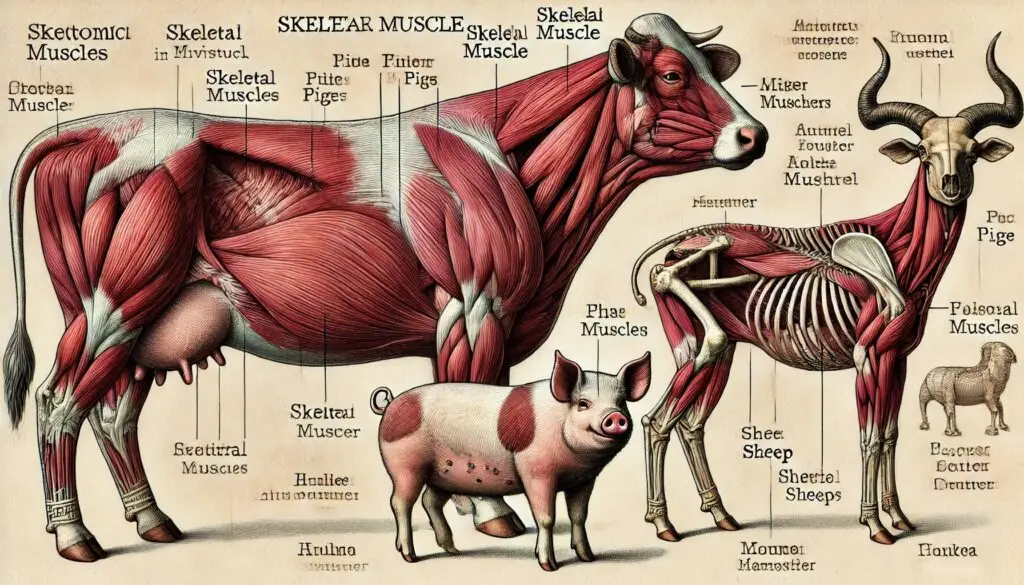Skeletal Muscle

Introduction to Skeletal Muscle
Skeletal muscle is vital for livestock. It not only provides the primary source of meat but also plays a crucial role in the animal’s overall health and productivity. Understanding skeletal muscle can help farmers improve meat quality and enhance animal welfare. This article will explore the development, composition, functions, and research implications of skeletal muscle in livestock.
What is Skeletal Muscle?
Skeletal muscle is a type of striated muscle tissue. It is responsible for voluntary movements and is attached to bones via tendons. This type of muscle is essential for locomotion and plays a significant role in the metabolic processes of the animal.
Composition of Skeletal Muscle
Skeletal muscle consists of:
- Muscle fibers: The basic units that contract to produce movement.
- Connective tissue: Provides structure and support.
- Adipose tissue: Stores fat and contributes to energy reserves.
The composition can vary based on factors like species, age, and diet. For more detailed information on muscle fiber types, check out this article on muscle fiber types.
Development of Skeletal Muscle
Myogenesis: The Formation of Muscle Fibers
Muscle fiber formation occurs through a process called myogenesis. This process begins during prenatal development and continues into early life.
Hyperplasia vs. Hypertrophy
There are two main ways that skeletal muscle develops:
- Hyperplasia: This refers to an increase in the number of muscle fibers. It primarily happens before birth.
- Hypertrophy: This is the growth of existing muscle fibers. It occurs after birth and can be influenced by factors such as nutrition and exercise.
For more on myogenesis, see this research article.
Factors Influencing Muscle Development
Several factors influence how skeletal muscle develops:
- Genetics: Different breeds have varying muscle growth rates.
- Nutrition: Adequate protein intake is crucial for muscle development.
- Exercise: Physical activity stimulates hypertrophy.
Understanding these factors can help farmers optimize their livestock management practices.
Functions of Skeletal Muscle
Skeletal muscle serves several important functions:
1. Movement
Skeletal muscles contract to facilitate movement. They work in pairs; when one contracts, the other relaxes. This coordination allows animals to walk, run, and perform other activities.
2. Metabolism
Muscle tissue is metabolically active. It uses carbohydrates and fats for energy production. This energy supports various biological functions such as growth and reproduction.
3. Thermoregulation
Skeletal muscles generate heat during contraction. This process helps maintain body temperature, especially in cold environments.
For a deeper understanding of how muscles contribute to metabolism, refer to this study on energy metabolism.
The Role of Satellite Cells
Satellite cells are essential for muscle repair and growth. Located next to muscle fibers, these cells can proliferate and fuse with existing fibers during periods of growth or after injury.
Importance of Satellite Cells
Satellite cells play a crucial role in:
- Muscle Repair: They help repair damaged fibers after injury or stress.
- Muscle Growth: They contribute additional nuclei to fibers during hypertrophy.
This regenerative capability is vital for maintaining healthy skeletal muscle throughout an animal’s life.
Impact on Meat Quality
The quality of meat produced by livestock depends significantly on skeletal muscle characteristics.
1. Muscle Fiber Composition
Different types of muscle fibers affect meat texture and flavor:
- Type I fibers (slow-twitch): These are more fatigue-resistant and are found in muscles used for endurance.
- Type II fibers (fast-twitch): These are larger and provide quick bursts of energy but fatigue faster.
For more information on how fiber types affect meat quality, check out this article on meat science.
2. Intramuscular Fat (Marbling)
Intramuscular fat contributes to the flavor and tenderness of meat. The presence of fat within the muscle enhances juiciness and overall palatability.
Factors Affecting Marbling
Several factors influence marbling:
- Genetics: Certain breeds have a genetic predisposition for higher marbling.
- Diet: Feeding strategies can enhance fat deposition within muscles.
Understanding these factors can help producers improve meat quality through better breeding and feeding practices.
Research Implications
Recent studies have focused on improving skeletal muscle health through various interventions.
In Vitro Cultivation of Muscle Cells
Researchers are exploring the potential for cultivating bovine myogenic cells in vitro as an alternative to traditional meat production methods. This approach aims to create more sustainable food sources while maintaining nutritional benefits.
For insights into this innovative research area, see this study on cell culture techniques.
Genetic Selection for Improved Traits
Genetic selection plays an important role in enhancing desirable traits related to skeletal muscle growth and quality. By selecting animals with favorable genetics, farmers can improve overall herd performance.
Technological Advances
Modern technologies such as genomic selection allow breeders to make informed decisions based on genetic data. This approach can lead to significant improvements in livestock production efficiency.
For more details about genetic selection methods, refer to this review article.
Conclusion
Skeletal muscle is a fundamental aspect of livestock that influences not only meat quality but also animal health and productivity. By understanding its development, functions, and implications for meat production, farmers can make informed decisions that enhance their operations.
More from Veterinary Anatomy:
Freezing Microtomes





Responses